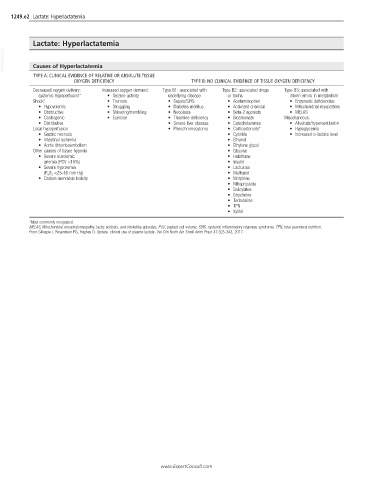Page 2505 - Cote clinical veterinary advisor dogs and cats 4th
P. 2505
1249.e2 Lactate: Hyperlactatemia
Lactate: Hyperlactatemia
VetBooks.ir Causes of Hyperlactatemia
TYPE A: CLINICAL EVIDENCE OF RELATIVE OR ABSOLUTE TISSUE
OXYGEN DEFICIENCY TYPE B: NO CLINICAL EVIDENCE OF TISSUE OXYGEN DEFICIENCY
Decreased oxygen delivery: Increased oxygen demand: Type B1: associated with Type B2: associated drugs Type B3: associated with
systemic hypoperfusion* • Seizure activity underlying disease or toxins inborn errors in metabolism
Shock* • Tremors • Sepsis/SIRS • Acetaminophen • Enzymatic deficiencies
• Hypovolemic • Struggling • Diabetes mellitus • Activated charcoal • Mitochondrial myopathies
• Obstructive • Shivering/trembling • Neoplasia • Beta-2 agonists • MELAS
• Cardiogenic • Exercise • Thiamine deficiency • Bicarbonate Miscellaneous:
• Distributive • Severe liver disease • Catecholamines • Alkalosis/hyperventilation
Local hypoperfusion • Pheochromocytoma • Corticosteroids* • Hypoglycemia
• Gastric necrosis • Cyanide • Increased D-lactate level
• Intestinal ischemia • Ethanol
• Aortic thromboembolism • Ethylene glycol
Other causes of tissue hypoxia • Glucose
• Severe euvolemic • Halothane
anemia (PCV <15%) • Insulin
• Severe hypoxemia • Lactulose
(P aO 2 <25-40 mm Hg) • Methanol
• Carbon monoxide toxicity • Morphine
• Nitroprusside
• Salicylates
• Strychnine
• Terbutaline
• TPN
• Xylitol
*Most commonly recognized.
MELAS, Mitochondrial encephalomyopathy, lactic acidosis, and strokelike episodes; PCV, packed cell volume; SIRS, systemic inflammatory response syndrome; TPN, total parenteral nutrition.
From Gillespie I, Rosenstein PG, Hughes D: Update: clinical use of plasma lactate. Vet Clin North Am Small Anim Pract 47:325-342, 2017.
www.ExpertConsult.com

